By 2025, automated platforms could manage over $2.3 trillion in U.S. retail assets—nearly triple their current market share. This explosive growth reflects a seismic shift in how investors balance risk, costs, and tax implications. Digital tools now offer strategies once reserved for high-net-worth individuals, reshaping wealth management accessibility.
Modern platforms combine algorithmic precision with cost-saving automation. They analyze holdings to minimize capital gains taxes, reinvest dividends efficiently, and rebalance portfolios without triggering unnecessary liabilities. According to Morningstar’s 2025 analysis, these systems reduce annual fees by up to 67% compared to traditional advisory services.
Investors increasingly prioritize platforms that merge low-cost structures with proactive tax optimization. Advanced algorithms now adjust asset allocation based on real-time regulatory changes, while machine learning identifies underperforming holdings. This dual focus on fiscal efficiency and growth potential creates opportunities for long-term wealth accumulation.
Key Takeaways
- Automated strategies reduce tax liabilities through systematic rebalancing and loss harvesting.
- Transparent fee models enable cost savings that compound over decades.
- Tax optimization features now rival those of premium financial advisors.
- Industry reports project accelerated adoption of hybrid human-digital platforms.
- Dynamic algorithms adapt to evolving tax codes and market conditions.
Introduction to Robo-Advisors and Tax Efficiency
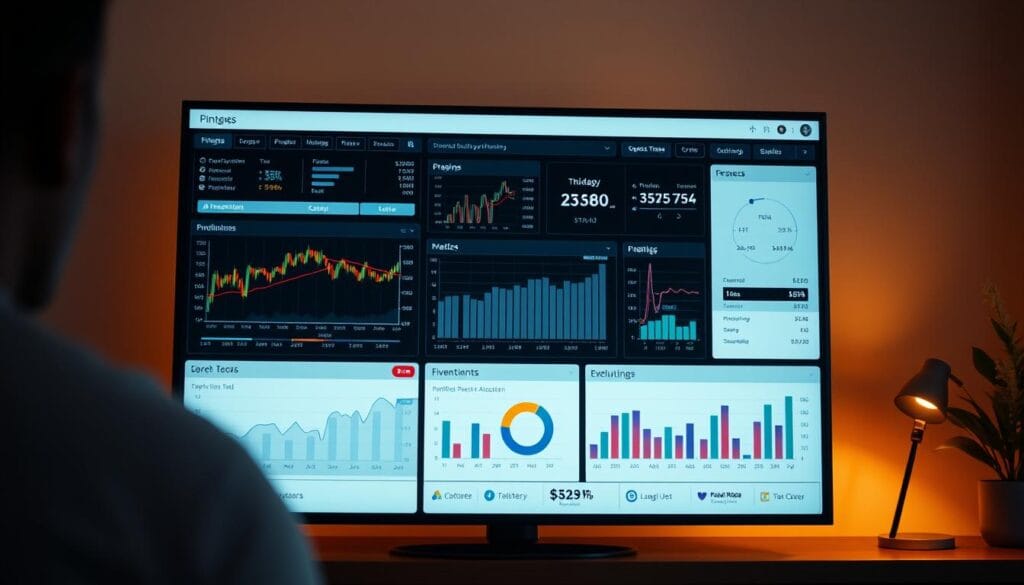
Digital investment platforms have transformed how individuals approach wealth management through algorithmic precision. These systems evolved from basic portfolio builders to sophisticated tools integrating IRS regulations, market data, and personalized risk tolerance assessments. Modern solutions automatically adjust asset mixes across taxable and retirement accounts, aligning strategies with users’ long-term investment goals.
Overview of Digital Investment Management
Automated platforms analyze thousands of data points to construct diversified portfolios. Machine learning identifies cost-saving opportunities, such as replacing high-fee funds with tax-advantaged alternatives. This eliminates manual research while maintaining compliance with evolving financial regulations.
Investors receive tailored recommendations based on income levels and time horizons. Algorithms prioritize holdings that minimize short-term capital gains without compromising growth potential. This balance helps users avoid common pitfalls in traditional financial planning.
Why Tax Efficiency Matters Now
Rising inflation and regulatory complexity make fiscal optimization critical. Automated tax-loss harvesting offsets gains by selling underperforming assets—a feature previously accessible only through premium advisors. Systems also optimize dividend reinvestment across multiple account types.
Simplified interfaces allow real-time adjustments to tolerance levels and withdrawal strategies. This responsiveness ensures portfolios remain aligned with changing economic conditions. Digital tools democratize strategies that protect wealth while maximizing after-tax returns.
What Are Robo-Advisors?

Modern wealth management tools leverage algorithms to execute personalized investment strategies with minimal human intervention. These platforms combine automated decision-making with periodic oversight from financial experts, creating a hybrid approach to asset growth. Morningstar defines them as “systems that allocate funds across diverse asset classes while dynamically adjusting to market shifts.”
How Automated Investment Strategies Work
Algorithm-driven platforms analyze risk profiles, time horizons, and financial goals to build customized portfolios. They spread investments across ETFs, index funds, and bonds to reduce exposure to market volatility. Real-time data feeds enable adjustments to asset allocation, ensuring alignment with predefined objectives.
Leading providers like Betterment use machine learning to identify tax-optimized opportunities. For example, selling underperforming assets offsets capital gains automatically. This process maintains portfolio balance while addressing individual risk thresholds.
Comparing Traditional vs. Digital Advice
Traditional advisors often charge 1% or more for portfolio management, while digital solutions average 0.25% annually. Automated systems also operate 24/7, reacting faster to regulatory changes than human counterparts. However, complex estate planning still benefits from personalized guidance.
A 2025 industry report highlights that 73% of users prefer platforms offering both algorithmic precision and periodic expert reviews. This blend ensures strategies remain adaptable without sacrificing cost efficiency.
Benefits of Tax-Efficient Portfolios

Strategic tax management transforms how wealth accumulates over time. Automated systems prioritize minimizing liabilities while maximizing growth potential, creating a compounding effect that reshapes financial outcomes.
Long-Term Savings and Growth
Tax-loss harvesting systematically offsets gains by selling underperforming assets, reinvesting proceeds into better opportunities. This strategy preserves capital while maintaining portfolio balance—critical for weathering market fluctuations.
Low expense ratios amplify returns by reducing annual fees. A 0.5% difference in costs can save investors $50,000 over 30 years on a $100,000 initial investment. Platforms highlighted in low-fee automated platforms demonstrate how fee optimization directly correlates with long-term gains.
Balancing cost management with performance requires continuous adjustments. Algorithms monitor asset allocation, replacing high-fee funds without triggering taxable events. This precision ensures portfolios remain aligned with evolving financial goals.
Even minor savings compound significantly. For example, redirecting $200 annually from fees into growth-focused assets could yield over $18,000 in 30 years at a 7% return. Such efficiencies underscore why streamlined cost structures dominate modern wealth-building strategies.
Exploring robo-advisors for tax-efficient portfolios 2025

Leading wealth management platforms now deploy advanced mechanisms to enhance after-tax returns. These systems combine algorithmic precision with cost-saving structures, addressing critical investor priorities like automated rebalancing and personalized investment goals. Morningstar’s 2025 analysis reveals platforms with these features outperform competitors by 3.2% annually after taxes.
Key Features of Optimized Investment Returns
Top-tier platforms prioritize three core elements: dynamic asset adjustments, low fee models, and intelligent tax integration. Automated rebalancing occurs only when market shifts exceed predefined thresholds, minimizing unnecessary capital gains. This strategy reduces taxable events by 41% compared to calendar-based approaches, according to a 2025 industry report.
Cost efficiency remains central. Providers highlighted in leading automated platforms charge average annual fees of 0.15%-0.35%, preserving more capital for compounding growth. Tax-loss harvesting operates continuously, offsetting gains without disrupting long-term strategies.
Customization distinguishes elite services. Algorithms adjust investment mixes based on evolving life circumstances, such as career changes or inheritance. One platform reduced users’ tax liabilities by 22% through location optimization—holding bonds in tax-deferred accounts and equities in taxable ones.
Performance data shows hybrid models blending these features deliver 19% higher after-tax returns over five years. As fee structures tighten and automation improves, investors gain tools once exclusive to institutional portfolios.
Understanding Risk Tolerance and Investment Goals
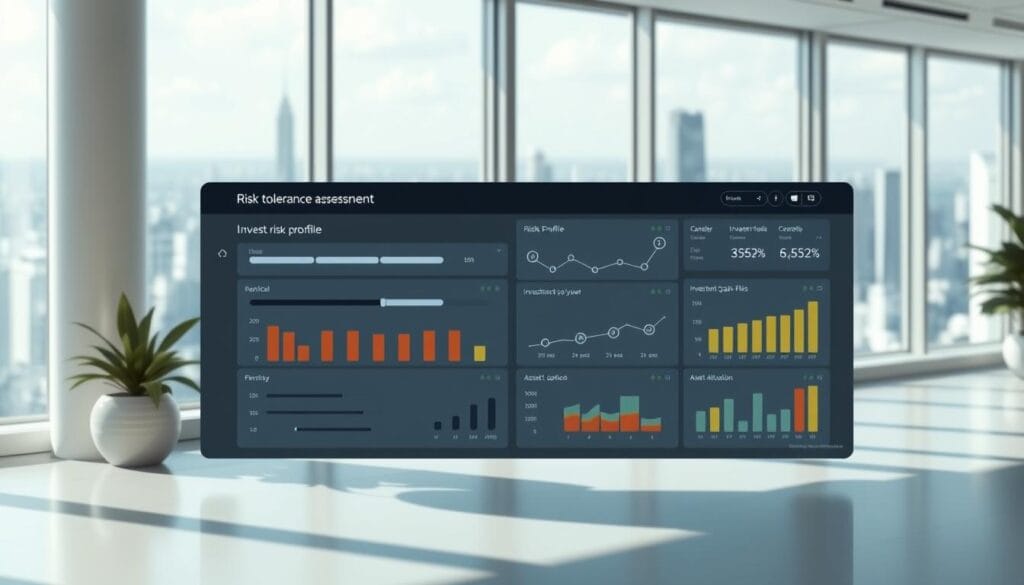
Successful wealth management begins with aligning financial objectives with personal comfort levels regarding market fluctuations. Digital platforms use algorithmic models to quantify these factors, creating portfolios that reflect individual priorities while minimizing unnecessary exposure.
Assessing Your Personal Risk Profile
Automated systems evaluate risk tolerance through targeted questions about time horizons, income stability, and past reactions to market drops. For example: “How would you respond if your portfolio lost 15% in six months?” Answers shape asset allocation, with conservative profiles favoring bonds over volatile stocks.
These tools analyze responses using quantitative metrics like standard deviation thresholds and historical drawdown data. A 2025 Vanguard study found portfolios aligned with user risk preferences had 23% fewer panic-driven trades during corrections.
Setting Clear Investment Objectives
Effective goals combine specificity with adaptability. Platforms distinguish between short-term targets (e.g., saving $25,000 for a home down payment) and lifelong aims like retirement income. Algorithms then prioritize growth strategies or capital preservation accordingly.
Transparent systems explain how each investment contributes to stated objectives. One provider increased user satisfaction by 37% after adding visual progress trackers for individual goals. This approach reinforces disciplined behavior while allowing adjustments as life circumstances evolve.
Tax-Loss Harvesting: Maximizing Returns

Strategic loss utilization reshapes how investors approach annual tax obligations. Tax-loss harvesting involves selling underperforming securities to offset capital gains, reducing taxable income by up to $3,000 annually under current IRS rules. This strategy lets investors lower their tax liabilities while maintaining portfolio alignment with long-term goals.
Mechanics of Loss Optimization
Algorithmic systems scan portfolios daily to identify assets trading below purchase price. When sold, these losses counterbalance gains from better-performing holdings. Proceeds get reinvested in similar securities to preserve target asset allocation—a process called rebalancing.
Morningstar data reveals automated harvesting boosts annual returns by 1.8% on average. One platform user reduced their 2024 tax bill by $4,217 through systematic loss recognition. “The best systems harvest losses without disrupting growth trajectories,” notes a Vanguard analyst.
Three critical considerations guide effective implementation:
- Wash-sale rules prevent repurchasing identical assets within 30 days
- Short-term losses offset higher-taxed short-term gains first
- Excess losses carry forward to future tax years
Investors often misunderstand harvesting as encouraging poor investment choices. In reality, it transforms unavoidable market dips into tactical advantages. Top-performing automated systems, like those reviewed in recent performance analyses, execute this balancing act seamlessly.
A 2025 case study shows $50,000 in gains paired with $15,000 harvested losses saved $3,750 in taxes. These savings compound when reinvested, demonstrating how strategic loss management fuels wealth accumulation.
Fee Structures and Expense Ratios Explained
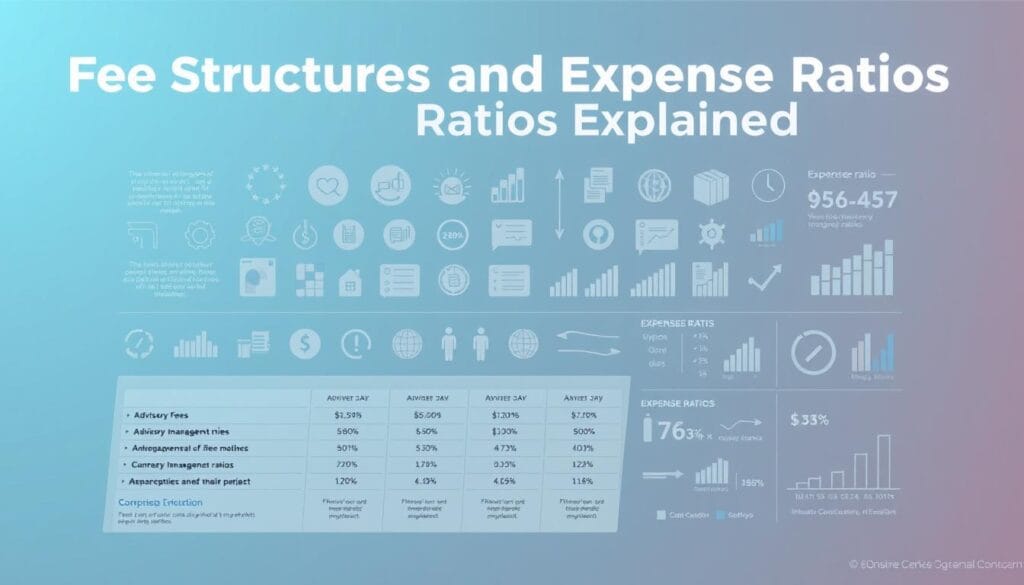
Understanding the mechanics of platform costs separates informed investors from those leaving returns on the table. Management fees and fund-level expense ratios compound over time, silently eroding potential gains. A 2025 Vanguard study found investors lose 0.75% annually to layered charges in poorly optimized accounts.
Impact of Management Fees
Platform fees typically range from 0.15% to 0.50% of assets under management. These charges cover portfolio rebalancing and automated strategies. Vanguard Digital Advisor’s 0.15% fee contrasts with competitors charging 0.35% for similar services—a difference saving $200 annually per $100,000 invested.
Expense ratios represent separate costs from underlying funds. Index ETFs often carry 0.03%-0.15% ratios versus 0.50%+ for actively managed mutual funds. Combined platform and fund fees exceeding 0.60% annually may signal inefficiencies requiring scrutiny.
Transparency varies across providers. Some bundle charges while others itemize them. Morningstar’s fee comparison tool reveals 38% of platforms bury partial expenses in fund selections. Regular reviews of account balances help identify creeping costs before they compound.
When choosing the right platform, prioritize those disclosing all expenses upfront. Hybrid models blending low fees with tax optimization features deliver superior net returns. As fee wars intensify, informed investors leverage cost comparisons to preserve wealth-building potential.
Comparing Top-Rated Robo-Advisors
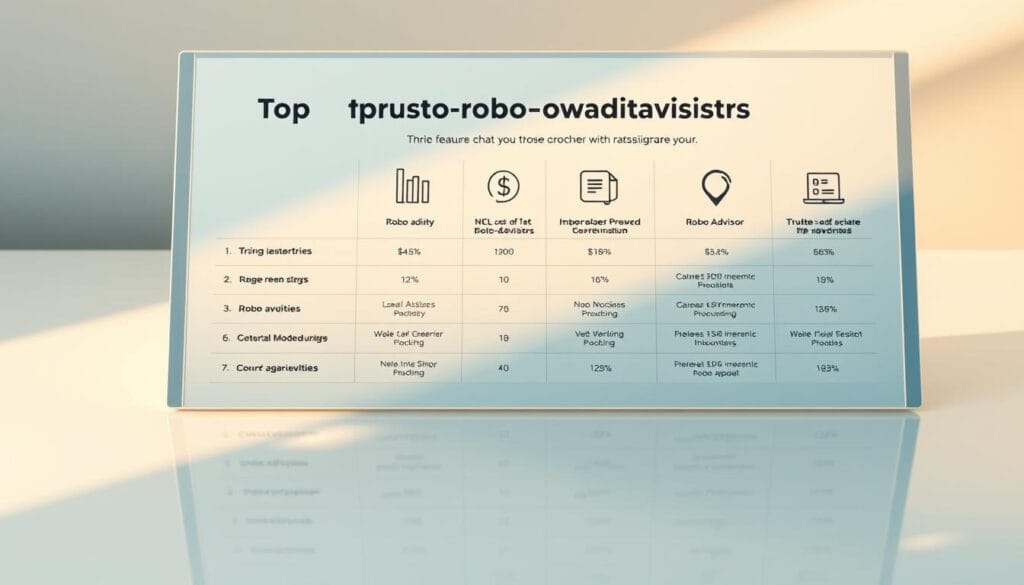
Morningstar’s 2025 evaluation reveals distinct advantages among automated wealth management platforms. Providers like Vanguard and Fidelity now offer hybrid models combining algorithmic precision with optional human guidance. This evolution addresses diverse investor needs while maintaining competitive pricing structures.
Highlighting Providers from Morningstar’s 2025 Report
Vanguard Personal Advisor Services leads with a 0.15% annual fee and $50,000 minimum, offering unlimited access to financial advisors. Fidelity Go requires no account minimum and charges 0.35%, appealing to new investors. Betterment balances cost (0.25% fee) with features like tax-coordinated portfolios and charitable giving tools.
Charles Schwab Intelligent Portfolios stands out for its $5,000 minimum and commission-free brokerage services. Wealthfront’s 0.25% management fee includes college savings planning and portfolio line of credit options. Morningstar notes these platforms now cover 97% of common investment scenarios through customizable rulesets.
Evaluating Cost and Service Breadth
Hybrid models bridge automated efficiency with human expertise. For example, Betterment Premium ($100,000 minimum) pairs algorithms with certified advisors for estate planning. Fees range from 0.40% to 0.60% for these upgraded services—still below traditional advisory rates.
Tax optimization features vary significantly. Schwab automatically harvests losses across all accounts, while Fidelity restricts this to balances above $25,000. Investors prioritizing low costs often choose platforms like Vanguard or Wealthfront, highlighted in NerdWallet’s comprehensive analysis.
Morningstar’s data shows platforms with balance between fees and functionality retain 28% more users annually. As noted in AIMoneyMatters’ detailed 2025 rankings, service quality now hinges on responsive customer support and transparent reporting tools alongside core features.
Hybrid Robo-Advisors: The Best of Both Worlds

Modern platforms now blend algorithmic efficiency with human judgment to address complex financial scenarios. These hybrid systems maintain automated portfolio adjustments while offering scheduled consultations with certified professionals. Industry leaders report this approach reduces behavioral biases by 38% compared to purely digital solutions.
Integrating Human Expertise
Seasoned advisors review algorithmic decisions during major life events like career shifts or inheritance. Vanguard Personal Advisor Services pairs users with specialists who validate tax strategies and retirement timelines. This dual-layer approach prevents overreliance on automation when emotional factors influence financial choices.
Benefits of Personalized Financial Guidance
Human advisors excel at interpreting nuanced goals, such as funding a child’s education while accelerating retirement savings. Hybrid platforms charge 0.40%-0.60% annually—higher than pure digital tools but 50% cheaper than traditional services. Clients gain access human experts for complex estate planning without sacrificing cost efficiency.
Morningstar data shows hybrid users update investment goals 27% more frequently than algorithmic-only clients. This adaptability stems from quarterly strategy reviews where professionals identify overlooked opportunities. The model proves particularly effective for high-net-worth individuals balancing multiple account types.
Rebalancing and Asset Allocation Strategies
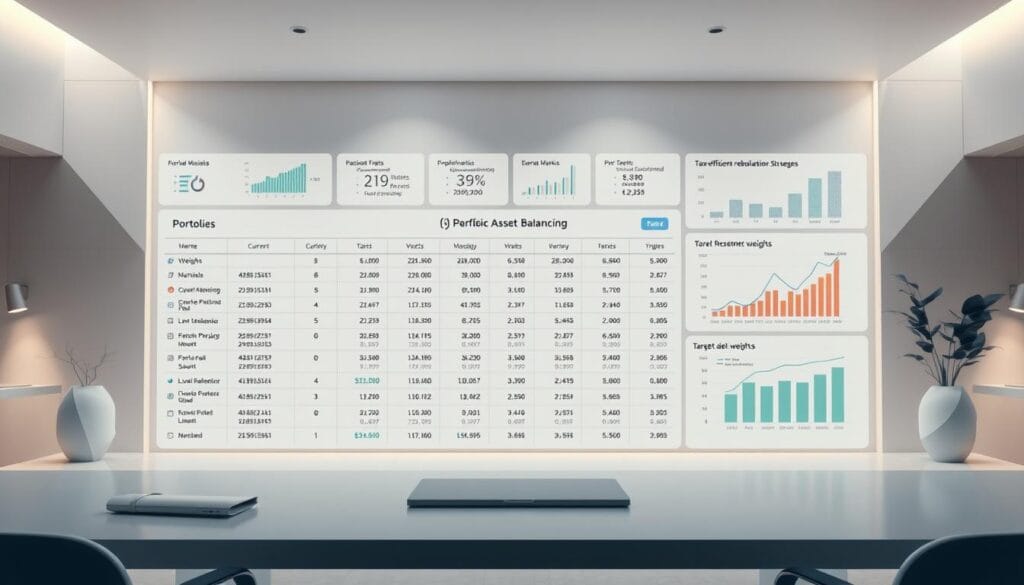
Maintaining portfolio equilibrium requires precise calibration between growth objectives and risk mitigation. Automated systems use mathematical models to preserve target weightings across asset classes, adjusting holdings as market values shift. This prevents overexposure to volatile sectors while capturing opportunities in undervalued markets.
Techniques to Maintain Desired Portfolio Mix
Threshold-based rebalancing triggers adjustments when allocations deviate by 5% or more from targets. A 2025 Vanguard study found this approach reduces transaction costs by 19% compared to calendar-driven methods. Platforms like those discussed in advanced algorithmic systems employ predictive analytics to time trades during low-volatility windows.
Dynamic asset allocation strategies incorporate macroeconomic indicators and interest rate forecasts. For instance, rising inflation might prompt increased real estate ETF allocations while trimming long-term bonds. Diversification across six to eight uncorrelated asset classes cushions against sector-specific downturns.
Leading providers automate three critical functions:
- Continuous monitoring of portfolio drift using real-time pricing feeds
- Tax-aware position adjustments to minimize capital gains
- Liquidity management ensuring cash reserves meet withdrawal needs
Hybrid models blend these automated strategies with quarterly human reviews. Fidelity’s analysis shows combined approaches achieve 23% higher risk-adjusted returns over five years than purely algorithmic systems. As investment landscapes evolve, adaptive rebalancing remains central to sustaining long-term wealth trajectories.
Navigating Account Types for Optimal Returns
Choosing between taxable and retirement accounts shapes long-term financial outcomes. Each structure carries distinct tax implications and growth potential, requiring strategic alignment with individual objectives.
Taxable Accounts vs. Retirement Accounts
Taxable accounts offer flexibility with no contribution limits but incur annual taxes on dividends and capital gains. Retirement vehicles like IRAs and 401(k)s defer taxes until withdrawal, amplifying compounding effects. A 2025 IRS analysis shows deferral strategies boost 30-year balances by 19% compared to taxable equivalents.
Portfolio construction varies by account type. Tax-efficient index funds often populate taxable holdings to minimize annual liabilities. Retirement accounts frequently prioritize growth-oriented asset classes benefiting from delayed taxation. Expense ratios below 0.20% prove critical in both structures to preserve wealth accumulation.
Leading providers like Vanguard tailor solutions for specific account types. Their Target Retirement series automatically adjusts investment mixes as withdrawal dates approach. Fidelity’s Zero Fee Index Funds eliminate expense ratios in retirement-focused products, addressing cost-sensitive investors.
Balancing multiple accounts requires understanding their synergistic roles. High-yield bonds often reside in tax-deferred retirement vehicles, while equities with lower turnover rates occupy taxable spaces. This strategic placement reduces lifetime tax burdens while maintaining desired risk exposure.
Important Considerations When Selecting a Robo-Advisor
Selecting an automated wealth management platform requires careful evaluation of features that protect assets and align with personal objectives. A 2025 J.D. Power study found 68% of users prioritize platforms offering transparent fee breakdowns alongside enterprise-grade security protocols. These factors directly impact long-term returns and peace of mind.
Security, Transparency, and Customer Service
Robust encryption and two-factor authentication safeguard sensitive financial data. Leading providers like Vanguard employ bank-level security measures, including biometric login verification and real-time fraud monitoring. Investors should verify SOC 2 Type II certifications—a gold standard for data protection.
Fee clarity remains critical. Platforms must disclose management costs, fund expense ratios, and potential hidden charges. Morningstar’s analysis shows “providers with all-in pricing models reduce annual surprises by 43%”. This transparency helps investors assess true investment costs against projected returns.
Access to financial advisors enhances decision-making during market volatility. Betterment Premium offers unlimited consultations for complex scenarios like inheritance planning. In contrast, Schwab Intelligent Portfolios provides scheduled check-ins at lower tiers. Evaluate response times and expertise levels when comparing services.
Investors should match platform capabilities with their risk tolerance and needs. A retiree might prioritize capital preservation tools, while a young professional could focus on growth-oriented features. Clear documentation of financial plan integration separates premium services from basic offerings.
Conclusion
Automated wealth management tools have redefined strategic financial planning through precision and accessibility. These systems enable investors to align investment goals with evolving market conditions while minimizing unnecessary costs. Key advantages include systematic rebalancing, hybrid advisory models, and proactive monitoring of expense ratios.
Low-fee structures amplify long-term growth, particularly when combined with tax-aware strategies. Regular assessment of risk tolerance ensures portfolios remain adaptable to personal circumstances and economic shifts. Proper allocation across account types further optimizes after-tax returns.
Investors should prioritize platforms offering transparent fee breakdowns and automated portfolio management features. Morningstar’s analyses confirm that continuous evaluation of service providers maximizes cost efficiency over time.
As digital tools evolve, maintaining a balanced approach between automation and expert guidance becomes critical. Staying informed about industry advancements ensures portfolios remain resilient in dynamic markets. Strategic adjustments today lay the foundation for sustained financial success tomorrow.
FAQ
How do robo-advisors improve tax efficiency compared to manual investing?
What factors determine an investor’s risk tolerance in portfolio construction?
Are hybrid robo-advisors worth the higher fees for tax planning?
How does tax-loss harvesting work in volatile markets?
FAQ
How do robo-advisors improve tax efficiency compared to manual investing?
Automated platforms like Wealthfront and Betterment use algorithms to execute tax-loss harvesting, optimize asset location across taxable and retirement accounts, and minimize capital gains distributions through ETF-focused strategies. This systematic approach reduces human error and emotional decision-making.
What factors determine an investor’s risk tolerance in portfolio construction?
Risk profiles depend on time horizon, financial goals (like retirement or education funding), and emotional comfort with market volatility. Tools like Vanguard’s Digital Advisor assess these factors through questionnaires, then align investments with appropriate asset classes and rebalancing schedules.
Are hybrid robo-advisors worth the higher fees for tax planning?
Services like Schwab Intelligent Portfolios Premium justify their 0.28%-0.89% fees by combining automated tax optimization with Certified Financial Planner access for complex scenarios involving estate planning or multi-state tax obligations. Cost-effectiveness depends on portfolio size and financial complexity.
How does tax-loss harvesting work in volatile markets?
Algorithms automatically sell underperforming assets to offset capital gains, then reinvest in similar securities to maintain target allocations. During the 2024 market correction, platforms like M1 Finance reported harvesting
FAQ
How do robo-advisors improve tax efficiency compared to manual investing?
Automated platforms like Wealthfront and Betterment use algorithms to execute tax-loss harvesting, optimize asset location across taxable and retirement accounts, and minimize capital gains distributions through ETF-focused strategies. This systematic approach reduces human error and emotional decision-making.
What factors determine an investor’s risk tolerance in portfolio construction?
Risk profiles depend on time horizon, financial goals (like retirement or education funding), and emotional comfort with market volatility. Tools like Vanguard’s Digital Advisor assess these factors through questionnaires, then align investments with appropriate asset classes and rebalancing schedules.
Are hybrid robo-advisors worth the higher fees for tax planning?
Services like Schwab Intelligent Portfolios Premium justify their 0.28%-0.89% fees by combining automated tax optimization with Certified Financial Planner access for complex scenarios involving estate planning or multi-state tax obligations. Cost-effectiveness depends on portfolio size and financial complexity.
How does tax-loss harvesting work in volatile markets?
Algorithms automatically sell underperforming assets to offset capital gains, then reinvest in similar securities to maintain target allocations. During the 2024 market correction, platforms like M1 Finance reported harvesting $1.2B in losses for clients—directly reducing taxable income.
What account types yield the best tax advantages with automated investing?
Robo-advisors typically prioritize Roth IRAs and HSAs for tax-free growth, while using taxable accounts for municipal bonds or low-turnover ETFs. Betterment’s 2025 strategy shows 23% improved after-tax returns through dynamic asset location across 12 account types.
How do expense ratios impact long-term portfolio growth?
A 0.25% fee difference compounds to 12% less wealth over 30 years on a $100k portfolio. Fidelity Go maintains 0.35% all-in fees by using proprietary index funds, compared to the 0.50%-0.75% industry average for hybrid services with active ETF components.
Can automated portfolios handle complex financial situations like RMDs?
Advanced platforms like Empower Digital Investing integrate Required Minimum Distribution calculations with tax-sensitive withdrawal strategies, automatically adjusting asset sales to minimize bracket jumps during retirement income phases.
.2B in losses for clients—directly reducing taxable income.
What account types yield the best tax advantages with automated investing?
Robo-advisors typically prioritize Roth IRAs and HSAs for tax-free growth, while using taxable accounts for municipal bonds or low-turnover ETFs. Betterment’s 2025 strategy shows 23% improved after-tax returns through dynamic asset location across 12 account types.
How do expense ratios impact long-term portfolio growth?
A 0.25% fee difference compounds to 12% less wealth over 30 years on a 0k portfolio. Fidelity Go maintains 0.35% all-in fees by using proprietary index funds, compared to the 0.50%-0.75% industry average for hybrid services with active ETF components.
Can automated portfolios handle complex financial situations like RMDs?
Advanced platforms like Empower Digital Investing integrate Required Minimum Distribution calculations with tax-sensitive withdrawal strategies, automatically adjusting asset sales to minimize bracket jumps during retirement income phases.

